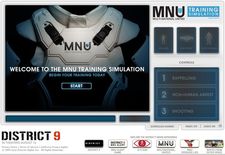Apocalyptic visions and alien invasions descended upon Hollywood earlier this month, to the collective delight of the digital media industry. At the American Film Institute’s DigiFest, which was produced by the AFI Digital Content Lab, attendees experienced two days of presentations and screenings focused on new media platforms and creative storytelling using digital innovations. The event spotlighted advanced productions from digital artists, as well as groundbreaking efforts from unknown content creators that are pushing the boundaries of what we perceive as big-budget effects.
The Purchase Brothers and DIY Filmmaking
On day two of the event, Suzanne Stefanac, director of the AFI Digital Content Lab, introduced two of the most talked-about innovators in do-it-yourself filmmaking: Ian and David Purchase, a.k.a. the Purchase Brothers. They created the low budget, but visually rich, short, “Escape from City 17.” This film combined existing digital assets (videogame backgrounds from Half-Life and photos from Wikipedia) with guerilla filmmaking (on-the-fly dialogue and trespassing on a local train depot), and three months of post-production work.
Watch the Purchase Brothers’ “Escape from City 17.”
“We thought they were among the most important new filmmakers to hit the scene this year,” said Stefanac. “What they did that set them apart was to teach themselves to meld live action cinema with a robust 3D game world. The resulting footage looks as though it cost many hundreds of thousands of dollars, perhaps even millions. But, in truth, they spent less than $500. Totally self-taught, they are among the new stars emerging from a moribund landscape.”
If the Purchase Brothers represent what’s possible on little or no budget, Digital Domain visual effects work on Sony Pictures’ “2012” represents the deep-pocketed end of the digital creative process. This is where large teams of specialized animators spend years creating jaw-dropping footage. Marten Larsson, CG effects animation lead at Digital Domain, demonstrated how they used a combination of open source tools and experimentation to layer, simulate and construct the apocalyptic scenes where buildings smash into each other, and cities fall into the ocean.
While Larsson wouldn’t reveal how much the two-minute scene he previewed cost to create, he did mention that 100 people spent a full year to develop it. That kind of expense would be truly apocalyptic to DIY filmmakers and indie film producers.
DigiFest presenters emphasized the myriad opportunities to create content and tell stories in ways that haven’t previously been done before, mainly due to technology or budget limitations. “The most exciting development on the digital tool front has to be the fact that all of the tools for conceptualizing, shooting, editing, distributing and promoting are becoming so democratized,” said Stefanac. “All of these tools can reside on one modest laptop.”
For Humans Only: The World of District 9
Laptops represent just one of many screens on which filmmakers and marketers are trying to engage and excite potential ticket buyers. Trigger, an entertainment and brand marketing agency, built the iPhone game and website for “2012,” and they also spearheaded the digital marketing initiatives for Sony Pictures’ “District 9.”

At DigiFest, Jason Yim, president and executive creative director of Trigger, walked attendees through the integrated marketing campaign for the movie. This included an augmented reality component and online game, as well as blogs and Twitter profiles from different perspectives (MNU: Multi-National United and @MultiNationalU | MNU Spreads Lies and @MNU_Lies) that were written in English and in an alien language. The campaign also included a MNU mobile marketing vehicle, and the ubiquitous bus bench sign that declared, “Bus Bench For Humans Only.”
“We started this campaign 18 months before the movie came out [and worked] based on the initial treatment, and before they started shooting,” said Yim. “So keeping the content updated and still on message even as the actual film evolved was a challenge. I think this speaks highly of the Sony team for creating a strategy that started within the confines of Comic-Con, but could grow and broaden over the next 14 months into an international campaign.”
Film Discovery and Anywhere Engagement
Discovering the next great film from self-starters like The Purchase Brothers or developing integrated, global marketing campaigns such as the one for “District 9,” are ongoing challenges for digital innovators.
“With the explosion of new content hitting every size screen, we need new filters, new ways of discovering stories that make us smarter, happier, better humans,” said Stefanac.
Yim draws inspiration from social media platforms and location-driven opportunities. “The iPhone, social media, GPS and augmented reality represent an evolutionary leap for digital marketing,” he said. “Combined, these innovations multiply the effectiveness of marketing by providing relevancy.”

He said the rapidly evolving nature of technology and online networks means marketers have to constantly adapt.
“Digital marketing has become exponentially more challenging and interesting because the tools are changing so quickly,” he said. “We are constantly asked to develop on new social networks around the world, and while our mobile programmers were busy delivering six iPhone apps this year we still had to staff and start prototyping on Blackberry and Android devices.”
****
What do you think are the most compelling digital opportunities for filmmakers or marketers? Share your thoughts in the comments.
Nick Mendoza is the director of digital communications at Zeno Group. He advises consumer, entertainment and web companies on digital strategy, distribution and engagement. He blogs at The Social 7 and is the film correspondent for MediaShift. Follow him on Twitter @NickMendoza.

